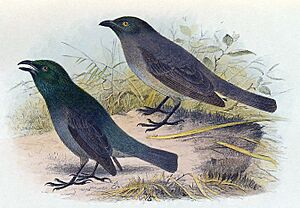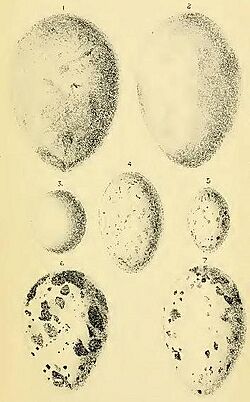Tasman starling facts for kids
Quick facts for kids Tasman starling |
|
|---|---|
| Conservation status | |
| Scientific classification | |
| Genus: |
Aplonis
|
| Species: |
fusca
|
| Synonyms | |
|
|
The Tasman starling (Aplonis fusca) was a type of bird that lived on Norfolk Island and Lord Howe Island. It was first described in 1836 by a scientist named John Gould. Later, in 1928, another bird expert, Gregory Macalister Mathews, noticed that the birds from Lord Howe Island looked a bit different. They were browner and more grey than the birds from Norfolk Island.
Because of these differences, the Tasman starling was split into two groups, called subspecies: the Norfolk starling (Aplonis fusca fusca) and the Lord Howe starling (Aplonis fusca hulliana). Sadly, both of these bird groups are now extinct, which means the entire Tasman starling species has disappeared forever.
Norfolk Starling: A Lost Bird of Norfolk Island
| Norfolk starling | |
|---|---|
 |
|
| Norfolk Island Tasman starling (Aplonis fusca fusca), from the collection Drawings of birds chiefly from Australia, (1791-1792) | |
| Conservation status | |
| Scientific classification |
|
| Kingdom: | Animalia |
| Phylum: | Chordata |
| Class: | Aves |
| Order: | Passeriformes |
| Family: | Sturnidae |
| Genus: | Aplonis |
| Species: |
†A. fusca
|
| Subspecies: |
†A. f. fusca
|
| Trinomial name | |
| Aplonis fusca fusca (Gould, 1836)
|
|
The Norfolk starling (Aplonis fusca fusca) was a small bird. It belonged to the starling family. This bird was a subspecies of the Tasman starling. It is now extinct, meaning it no longer exists.
Where the Norfolk Starling Lived
The Norfolk starling could only be found on Norfolk Island. This island is an Australian territory. It is located in the Tasman Sea, which is between Australia and New Zealand.
What the Norfolk Starling Looked Like
The Norfolk starling was about 20 centimeters (8 inches) long. Its wings were about 9.8 to 10.3 centimeters long. The tail was 6.3 to 6.8 centimeters long. Its bill was about 1.3 centimeters, and its legs were 2.5 centimeters long.
These birds were mostly greyish-brown. Male birds had a shiny, metallic green color on their heads and throats. Their backs, rumps, and wings were grey. The underside of their bodies was also grey. However, the feathers under their tails were whitish. Their bills were black, and their eyes were a bright orange-red.
Female Norfolk starlings looked similar to males. But their green colors were not as shiny. Their grey throats stood out against their pale brownish sides. The lower part of their chest had a yellowish tint. Their bellies and undertail feathers were yellowish-white.
Why the Norfolk Starling Disappeared
It is not fully clear why the Norfolk starling became extinct. Several things might have caused its disappearance. Other birds, like European starlings, song thrushes, and common blackbirds, were brought to the island. These new birds might have competed with the Norfolk starling for food and homes.
People also hunted these birds. And their homes were lost as land was cleared for farming. Some old stories said that rats caused their extinction. But this is not true for the Norfolk starling. Rats did not become a big problem on Norfolk Island until 1940. The last time a Norfolk starling was seen alive was in 1923.
Lord Howe Starling: Another Lost Bird
| Lord Howe starling | |
|---|---|
 |
|
| Conservation status | |
| Scientific classification |
|
| Kingdom: | Animalia |
| Phylum: | Chordata |
| Class: | Aves |
| Order: | Passeriformes |
| Family: | Sturnidae |
| Genus: | Aplonis |
| Species: |
†A. fusca
|
| Subspecies: |
†A. f. hulliana
|
| Trinomial name | |
| Aplonis fusca hulliana (Mathews, 1928)
|
|
| Synonyms | |
|
|
The Lord Howe starling (Aplonis fusca hulliana) was a small bird. It was also part of the starling family. This bird was another extinct subspecies of the Tasman starling. It only lived on Lord Howe Island. This island is in the Tasman Sea and is part of New South Wales, Australia.
What the Lord Howe Starling Looked Like
The Lord Howe starling was about 18 centimeters (7 inches) long. Its head, neck, and throat were a shiny, metallic green. Its back was a slaty grey color with a dull green shine. The rump and the underside of its body were grey. Its tail was grey with brownish tips on the feathers. The wings were a rich brown color. Like its Norfolk cousin, its eyes were orange-red.
Life and Habits of the Lord Howe Starling
The people on Lord Howe Island called these starlings "red-eyes" because of their eye color. They also called them "cudgimeruk" because of their special calls. These birds lived in forests. They usually stayed and looked for food in pairs.
When it was time to nest, the female would lay four to five bluish-green eggs. These eggs had red spots. The nests were built in hollows inside dead trees or tree ferns.
Why the Lord Howe Starling Disappeared
The fate of the Lord Howe starling was sealed in June 1918. A ship called the SS Makambo got stuck at Ned's Beach. This allowed black rats to leave the ship and spread all over the island.
Within just two years, 40% of the bird species that only lived on Lord Howe Island became extinct. This included birds like the Lord Howe fantail, the Lord Howe gerygone, and the robust white-eye. The Lord Howe starling completely disappeared by 1919.




